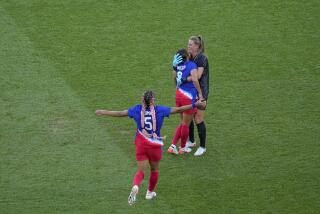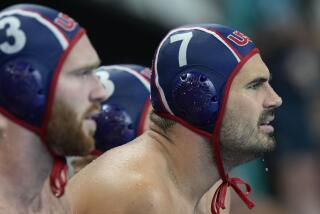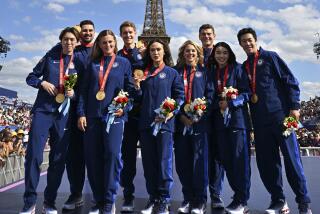Eldredge Plans to Take New Move for Spin
- Share via
SALT LAKE CITY — Old skaters can learn new tricks.
Somewhere between last month’s U.S. figure skating championships and the first official Olympic practices, 30-year-old U.S. men’s champion Todd Eldredge learned how to consistently land a quadruple toe loop. That’s an encouraging omen for the six-time U.S. champion as he approaches his third Winter Games and chases the one great performance he hasn’t had on the Olympic stage.
Eldredge, who has landed only two quads in competition, said Wednesday he has been hitting about 75% to 80% of his quadruple jump attempts in recent weeks, up from about 60%
“The percentages have gotten a little bit better, so confidence obviously gets a little bit better as percentages get better,” he said after landing a quad toe-double toe combination during his practice at the Salt Lake Ice Center. “It’s definitely different, so I feel a little bit better about it.”
He tried a quad at the U.S. championships but changed it in mid-air to a triple, a switch that didn’t keep him from winning. But Eldredge, who was 10th at the 1992 Albertville Games and fourth at Nagano in 1998, knows landing a quad will be imperative here against such strong jumpers as Alexei Yagudin and Evgeny Plushenko of Russia and U.S. compatriot Tim Goebel.
He’s not sure, however, if he will try the quad combination in the short program next Tuesday or in the long program, next Thursday.
“It’s strategy, with the draw, and how the other guys do,” he said. “But it’s always Plan A, to go ahead and do it [in the short program]. If we need it, we’ll do it. If we don’t, we’ll go to Plan B and hopefully be in good position for the long program.
“If I skate early and all of the guys that are kind of the top guys skate after me, then it kind of depends on how I feel that day. If I feel great, then I’ll do it. If I feel a little off, it’s stupid to risk making a mistake. I’ll go out there and just skate clean and put some pressure on those guys to go out there and do theirs.”
Goebel, who was the 2001 U.S. champ but finished second to Eldredge last month, also took advantage of Wednesday’s practice at the Olympic venue. The third U.S. entry, Michael Weiss, skipped the session.
Goebel, a first-time Olympian who trains in El Segundo, arrived Monday after spending about 10 days training in Colorado Springs, Colo., to get accustomed to altitude. He spent much of Tuesday touring the athletes’ village and was impressed with the facilities.
“I can’t believe it,” he said. “I was expecting a few little buildings for the athletes and a dining hall. It’s so much more than that. There’s so much. There’s a coffee shop, which is great because I’m a coffee person. I like coffee. And they have the Internet everywhere, which is great, so I can do my e-mail. And they have a game room with X Box and PlayStation 2 and a lot of cool stuff.
“I’ve seen a lot of people from other U.S. sports and that’s always nice. It’s such a rare opportunity I get to see anyone out of skating.”
Too Good to Be True
An asterisk should accompany the 31-0-0 record compiled by the U.S. women’s hockey team.
Because they were too good for even traditional rival Canada to have challenged them much, the U.S. women played some games against boys’ teams to keep their skills sharp. And although they lost some of those games, none of the results was counted in the official record.
Their opponents were select teams, 16- or 17-year-old boys who are all-stars in their districts. From those games, said U.S. defenseman Angela Ruggiero, came the Olympic team’s sternest tests.
“Those guys haven’t quite yet filled out physically, but they’re very, very skilled,” said Ruggiero, formerly of Simi Valley. “You’ve got to make faster passes against them and they’re going to try to beat you wide, and as a defenseman, that’s great practice. They abided by our [no-checking] rules, but those games were still very, very physical, and we have been pushed.
“It would be nice if some of the [women’s] teams in international play were at a higher level, but progress comes in small steps, and they’re going to take those steps by playing us. We’ve sort of set the standard.”
Ruggiero, 22, was among the youngest U.S. players in 1998, when women’s hockey made its Olympic debut and the U.S. defeated Canada in the gold-medal game. However, when the U.S. begins play Tuesday against Germany at the E Center, there will be five players younger than she is. For Ruggiero, who has completed two years at Harvard and will return this fall after a two-year absence, Salt Lake City will be familiar territory.
“This time around there are 14 veterans,” she said. “We know what to expect from travel, competitions, even going to the Olympics, we know what the processing is like and the opening ceremony.
“The biggest difference is the support we’ve gotten from the fans and media who are paying more attention because we won last time. We had 10,000 fans in Detroit, which is my adopted hometown now, and it was great. People were surprised last time around that women’s hockey exists. Now it’s, ‘Oh, the women’s hockey team is coming to town. We should go.’ There’s still a lot of growth to be had, but being on TV during the Olympics will really help the sport.”
The Peter Principle
Like any good negotiator, Peter Stastny asked for a lot and got a little less than he wanted, but enough to come away happy.
Stastny, the former NHL standout who has become general manager of Slovakia’s Olympic hockey team, knew NHL teams wouldn’t grant his request to release all their Slovak players for all three preliminary round games at Salt Lake City. But his pleas got him a game or two from Ziggy Palffy, Lubomir Visnovsky, Pavol Demitra, Jozef Stumpel, Miroslav Satan and others, and three games from Lubos Bartecko.
Although Slovakia might have only 14 players in uniform for some games because it kept roster spots open for NHL stars, Stastny is hopeful his team can advance to the main round against Canada, the U.S., Sweden, Finland, Russia and the Czech Republic.
“I’m happy with where we are,” said Stastny, who got four players for all three games as well as two minor leaguers, to supplement a roster built around Slovaks playing at home and in Europe. “I believe it is beneficial for everybody, for the young players, for the Olympic Games and hockey players around the world, to have these players play for Slovakia.”
Stastny played for Czechoslovakia at the 1980 Olympics and was still active in 1994 when Slovakia became an independent nation. He carried his nation’s flag into the opening ceremony at Lillehammer, beaming all the while.
“We fought to be at the Olympics, to have a chance to participate,” he said, “and at the age I was [37], I appreciated being there. I have wonderful memories.”
Here and There
Canadian snowboarder Ross Rebagliati’s hopes of watching the Olympics apparently have gone up in smoke. Rebagliati won gold at Nagano only to have it taken away after he tested positive for marijuana. His triumph was reinstated after he argued he had been exposed to second-hand smoke at a farewell party, and the International Olympic Committee remembered marijuana wasn’t on its list of banned drugs. He planned to be a spectator at Salt Lake City, but he told a Canadian TV network last week that U.S. immigration officials won’t let him into the country because he acknowledged using marijuana in the past.
U.S. men’s hockey coach Herb Brooks said he’s concerned about injuries to two key players. Goalie Tom Barrasso has a groin pull and defenseman Brian Rafalski has a bad knee. “NHL players today are paying a price to participate in the Olympics,” he said. “It’s a really condensed schedule and it’s a difficult thing to go through.”
The Salt Lake City Games will be the first in which instant video replay will be available to figure skating judges. The system was first used at the 1999 European championships and has been used at subsequent world championships.
More to Read
Go beyond the scoreboard
Get the latest on L.A.'s teams in the daily Sports Report newsletter.
You may occasionally receive promotional content from the Los Angeles Times.







